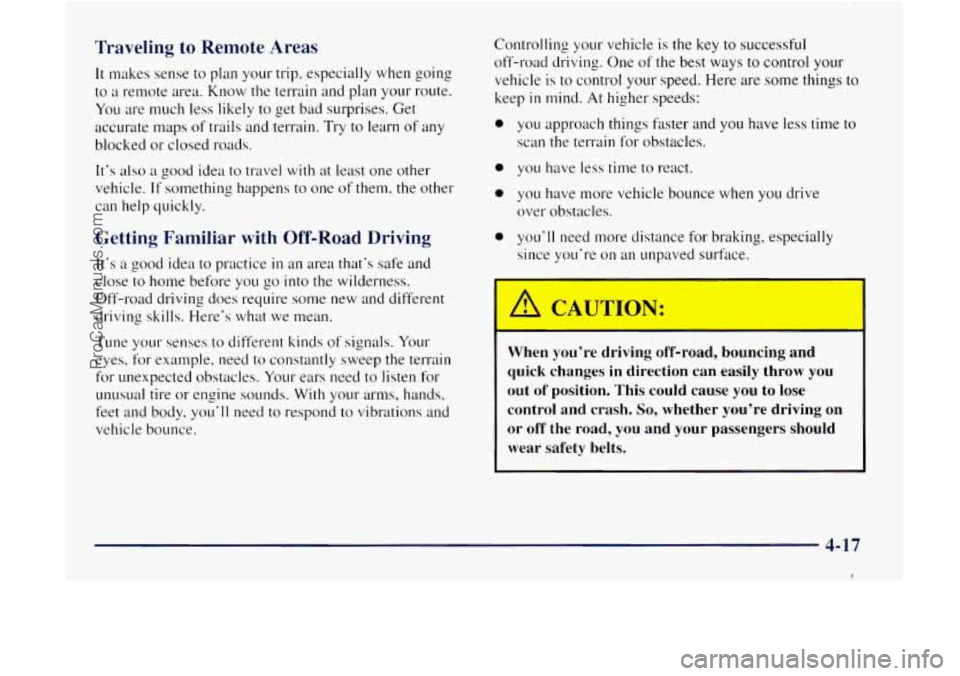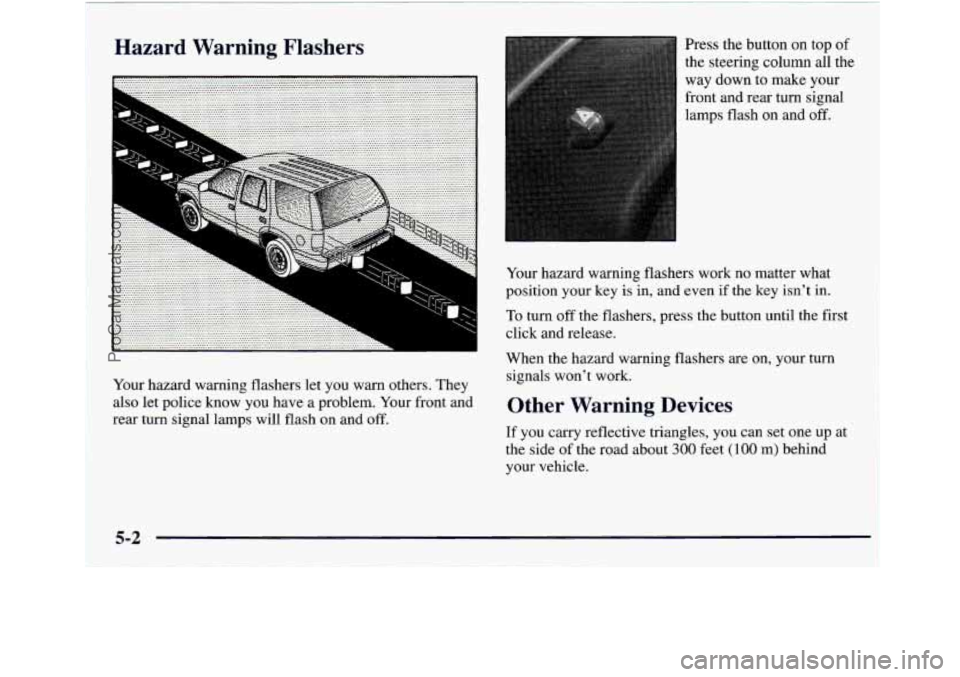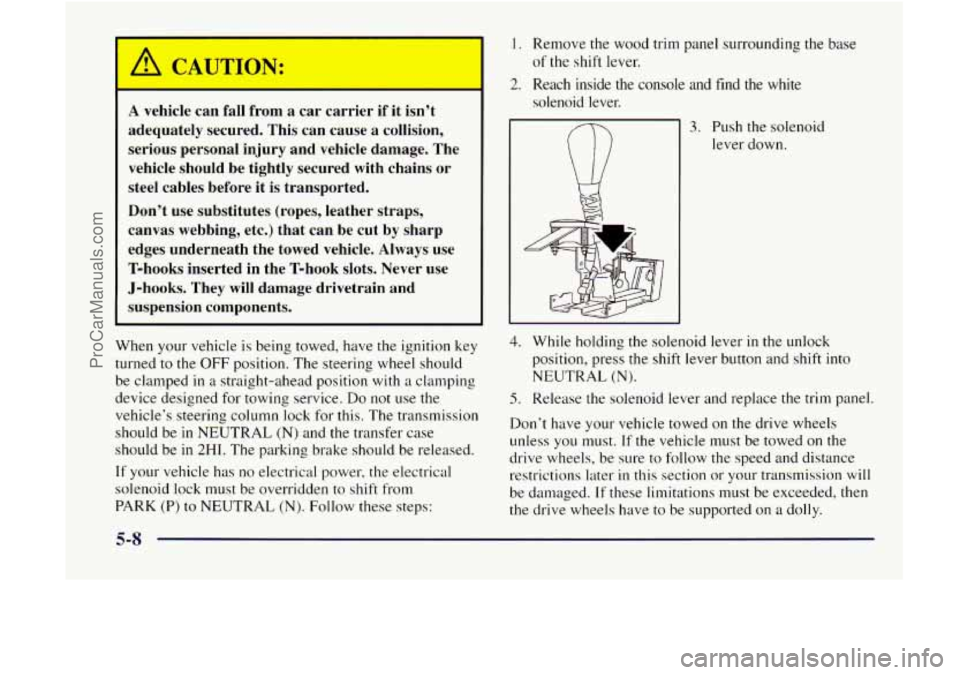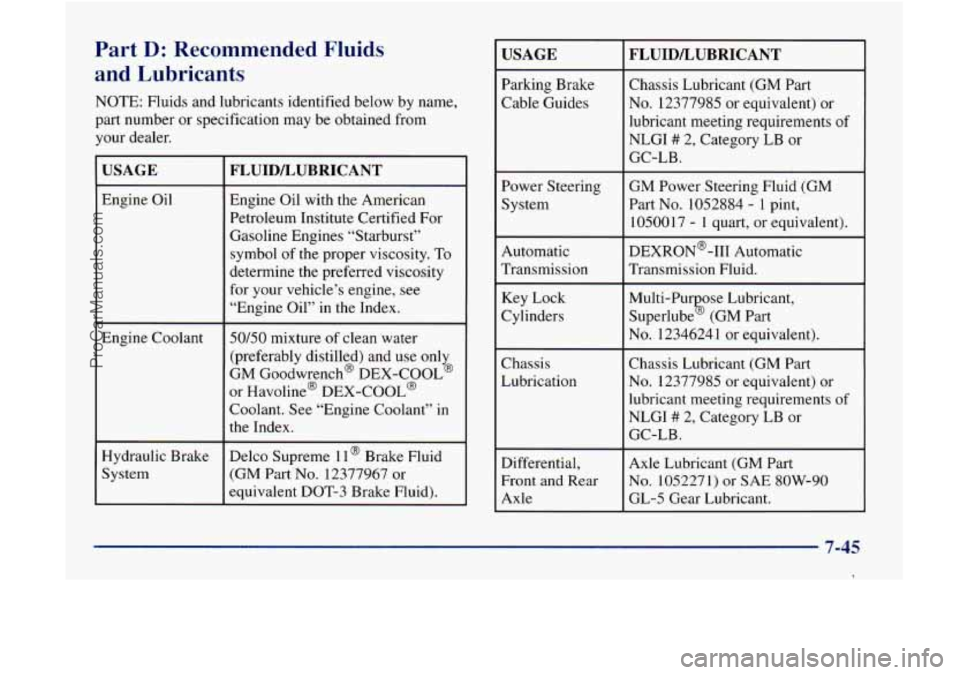key GMC ENVOY 1998 Owner's Guide
[x] Cancel search | Manufacturer: GMC, Model Year: 1998, Model line: ENVOY, Model: GMC ENVOY 1998Pages: 386, PDF Size: 20.33 MB
Page 176 of 386

Traveling to Remote Areas
It makes sense to plan your trip, especially when going
to
a remote area. Know the terrain and plan your route.
You are much less likely to get bad surprises. Get
accurate maps of trails and terrain. Try to learn of any
blocked
or closed roads.
It’s also a good idea to travel with at least one other
vehicle.
If something happens to one of them, the other
can help quickly.
Getting Familiar with Off-Road Driving
It’s a good idea to practice in an area that’s safe and
close
to home before you go into the wilderness.
Off-road driving does require some new and different
driving skills. Here’s what we mean.
Tune your senses to different kinds of signals. Your
eyes, for example, need to constantly sweep the terrain
for unexpected obstacles. Your ears need to listen for
unusual tire or engine sounds. With your arms, hands,
feet and body.
you‘ll need to respond to vibrations and
vehicle bounce. Controlling
your vehicle is the
key to successful
off-road driving. One
of the best ways to control your
vehicle is
to control your speed. Here are some things to
keep
in mind. At higher speeds:
0 you approach things faster and you have less time to
scan the terrain for obstacles.
0 you have less time to react.
0 you have more vehicle bounce when you drive
over obstacles.
0 you’ll need more distance for braking, especially
since you’re on an unpaved surface.
A c. u7c-i:
When you’re driving off-road, bouncing and
quick changes in direction can easily throw you
out of position. This could cause you
to lose
control and crash.
So, whether you’re driving on
or off the road, you and your passengers should
wear safety belts.
4-17
I
ProCarManuals.com
Page 213 of 386

I’ :---d Warning Flashers
Your hazard warning flashers let you warn others. They
also let police know you have a problem. Your front and
rear turn signal lamps will flash
on and off. Press the button
on top of
the steering
column all the
way down to make your
front and rear turn signal
lamps flash on and
off.
Your hazard warning flashers work no matter what
position your key
is in, and even if the key isn’t in.
To turn
off the flashers, press the button until the first
click and release.
When the hazard warning flashers
are on, your turn
signals won’t work.
Other Warning Devices
If you carry reflective triangles, you can set one up at
the side of the road about
300 feet (100 m) behind
your vehicle.
5-2
ProCarManuals.com
Page 219 of 386

JTION:
A vehicle can fall from a car carrier if it isn’t
adequately secured. This can cause
a collision,
serious personal injury and vehicle damage. The
vehicle should be tightly secured with chains or
steel cables before it is transported.
Don’t use substitutes (ropes, leather straps,
canvas webbing, etc.) that can be cut by sharp
edges underneath the towed vehicle. Always use
T-hooks inserted in the T-hook slots. Never use
J-hooks. They will damage drivetrain and
suspension components.
When your vehicle is being towed, have the ignition key
turned
to the OFF position. The steering wheel should
be clamped
in a straight-ahead position with a clamping
device designed for towing service.
Do not use the
vehicle’s steering column lock for this. The transmission
should be in NEUTRAL
(N) and the transfer case
should be
in 2HI. The parking brake should be released.
If your vehicle has no electrical power, the electrical
solenoid lock
must be overridden to shift from
PARK (P) to NEUTRAL (N). Follow these steps:
1 I Remove the wood trim panel surrounding the base
2. Reach inside the console and find the white of the shift lever.
solenoid lever.
(ii
3. Push the solenoid
lever down.
4. While holding the solenoid lever in the unlock
position, press the shift lever button and shift into
NEUTRAL
(N).
5. Release the solenoid lever and replace the trim panel.
Don’t have your vehicle towed on the drive wheels
unless
you must. If the vehicle must be towed on the
drive wheels, be sure to follow the speed and distance
restrictions later
in this section or your transmission will
be damaged. If these limitations must be exceeded, then
the drive wheels have to be supported
on a dolly.
5-8
ProCarManuals.com
Page 351 of 386

At Least Twice a Year
Restraint System Check
Make sure the safety belt reminder light and all your
belts, buckles, latch plates, retractors and anchorages are
working properly. Look for any other
loose or damaged
safety belt system parts.
If you see anything that might
keep a safety belt system from doing its
job, have it
repaired. Have any torn or frayed safety belts replaced.
Also look for any opened or broken air bag coverings,
and have them repaired or replaced. (The air bag system
does not need regular maintenance.)
Wiper Blade Check
Inspect wiper blades for wear or cracking. Replace blade
inserts that appear worn or damaged or that streak or
miss areas of the windshield. Also see “Wiper Blades,
Cleaning”
in the Index.
Automatic Transmission Check
Check the transmission fluid level; add if needed. See
“Automatic Transmission’’ in the Index. A fluid loss
may indicate
a problem. Check the system and repair
if needed.
At Least Once a Year
Key Lock Cylinders Service
Lubricate the key lock cylinders with the lubricant
specified in Part
D.
Body Lubrication Service
Lubricate all body door and fuel door hinges, rear
compartment hinges, latches and locks including
the
glove box, console doors and the body hood and any
moving seat hardware. Lubricate the hood safety lever
pivot and prop rod pivot. Part
D tells you what to use.
More frequent lubrication may be required when
exposed to
a corrosive environment.
7-40
ProCarManuals.com
Page 352 of 386

Starter Switch Check Brake-Transmission Shift Interlock (BTSI) Check
When you are doing this check, the vehicle could
move suddenly.
If it does, you or others could be
injured. Follow the steps below.
A CAUTION:
I
When you are doing this check, the vehicle could
move suddenly. If it does, you
or others could be
injured. Follow the steps below.
1. Before you start, be sure you have enough room
around
the vehicle.
2. Firmly apply both the parking brake (see “Parking
Brake”
in the Index if necessary) and the
regular brake.
NOTE:
Do not use the accelerator pedal, and be
ready
to turn off the engine immediately if it starts.
3. Try to start the engine in each gear. The starter
should work only in PARK (P) or NEUTRAL (N).
If the starter works in any other position, your
vehicle needs service.
1. Before you start, be sure you have enough room
around the vehicle.
It should be parked on a
level surface.
2. Firmly apply the parking brake (see “Parking Brake”
in the Index if necessary).
NOTE: Be ready to apply the regular brake
immediately if the vehicle begins to move.
3. With the engine off, turn the key to the RUN
position, but don’t start the engine. Without applying
the regular brake, try
to move the shift lever out of
PARK
(P) with normal effort. If the shift lever
moves out of PARK
(P), your vehicle’s BTSI
needs service.
7-41
!
ProCarManuals.com
Page 353 of 386

Ignition Transmission Lock Check
While parked, and with the parking brake set, try to turn
the ignition key to LOCK
in each shift lever position.
The key should turn to LOCK only when the shift
lever is in PARK (P).
The key should come out only in LOCK.
Parking Brake and Automatic Transmission
PARK
(P) Mechanism Check
b-
When you are doing this check, your vehicle
could begin to move.
You or others could be
injured and property could be damaged. Make
sure there is room in front
of your vehicle in case
it begins to roll. Be ready to apply the regular
brake
at once should the vehicle begin to move.
Park on a fairly steep hill, with the vehicle facing
downhill. Keeping your foot
on the regular brake, set the
parking brake.
0 To check the parking brake’s holding ability:
With the engine running and transmission in
NEUTRAL
(N), slowly remove foot pressure from
the regular brake pedal.
Do this until the vehicle is
held by the parking brake only.
0 To check the PARK (P) mechanism’s holding ability:
With the engine running, shift to PARK
(P). Then
release all brakes.
Underbody Flushing Service
At least every spring, use plain water to flush any
corrosive materials from the underbody. Take care
to
clean thoroughly any areas where mud and other debris
can collect.
7-42
ProCarManuals.com
Page 356 of 386

Part D: Recommended Fluids
and Lubricants
NOTE: Fluids and lubricants identified below by name,
part number or specification may be obtained from
your dealer.
USAGE
Engine Oil
Engine Coolant
Hydraulic Brake
System
FLUIDLUBRICANT
Engine Oil with the American
Petroleum Institute Certified For
Gasoline Engines “Starburst” symbol of the proper viscosity. To
determine the preferred viscosity
for your vehicle’s engine, see
“Engine Oil” in the Index.
50/50 mixture of clean water
(preferably distilled) and use
only
GM Goodwrench@ DEX-COOL@
or Havoline@ DEX-COOL@
Coolant. See “Engine Coolant’’
in
the Index.
Delco Supreme
1 1 @ Brake Fluid
(GM Part No. 12377967 or
equivalent DOT-3 Brake Fluid).
USAGE
Parking Brake
Cable Guides
Power Steering System
Automatic
Transmission
Key Lock
Cylinders
Chassis
Lubrication
Differential,
Front and Rear
Axle
FLUIDLUBRICANT
Chassis Lubricant (GM Part
No. 12377985 or equivalent) or
lubricant meeting requirements of
NLGI
## 2, Category LB or
GC-LB.
GM Power Steering Fluid (GM
Part
No. 1052884 - 1 pint,
10500 17 - 1 quart, or equivalent).
DEXRON@-I11 Automatic
Transmission Fluid.
Multi-Pu
ose Lubricant,
Superlube
% (GM Part
No. 1234624 1 or equivalent).
Chassis Lubricant
(GM Part
No. 12377985 or equivalent) or
lubricant meeting requirements
of
NLGI # 2, Category LB or
GC-LB.
Axle Lubricant (GM Part
No. 1052271) or SAE 8OW-90
GL-5 Gear Lubricant.
7-45
ProCarManuals.com
Page 364 of 386

Roadside Assistance
In
GMC’s Roadside Assistance provides stranded owners
with over-the-phone roadside repairs, location
of the
nearest GMC dealer or the following special services:
Flat Tire Chunge: Installation of spare tire will be
covered at
no charge (customer is responsible for repair
or replacement
of tire).
Fuel Delivery: Delivery
of enough fuel for the customer
to get
to the nearest service station (up to $4.00) will
be covered.
Jump Sturt: No-start situations which require a battery
jump start will be covered at no charge.
Luck Out: Replacement keys or locksmith service will
be covered at no charge if you are unable to gain entry
into your vehicle. Delivery
of the replacement key will
be covered at no charge within 10 miles (16 km).
Emergency Towing Service: Towing to the nearest
GMC dealer
for warranty related disablements will
be covered.
8-5
ProCarManuals.com
Page 374 of 386

Section 9 Index
Accessory Inf’lator ............................. 2-50
Acces~~ty
POWC~ Outlets ......................... 2-52
Adcling Sound Equilm1cnt
........................ 3-23
Add-On Equiptnent
............................. 4-43
Air Bag
Adding Equipment ............................ 1-27
How Does it Restrain .......................... 1-25
How it Works ................................ I -23
Location
.................................... 1-23
Readiness Light
......................... 1-22 . 2-63
Servicing
................................... 1-27
What
Makes it Inflate .......................... 1-25
What
You See After it Inflates ................... 1-25
When Should
it Inflate ......................... 1-24
Air Cleaner .................................... 6- 14
Air Conditioning ................................ 3-5
Refripxants
................................. 6-62
Alignment
and Balancc. Tire ...................... 6-13
Atltenn.1.
Fi~d ................................. 3-26
Adcling
Equipment
to the Outside of’ Your Vehicle ...... 6-3
AllIt11inLll11 Wheels . Clea11i11~ ...................... 6-5 1
Anti-Lock Brake System Wa~ming Light ......... 2-66 . 4-7
Appearance
Care ............................... 6-45
Materials
.................................... 6-53
Arbit~-ation Program .............................. 8-9
Ar111rest . Storage ............................... 2-15 Ashtrays
...................................... 2-49
Audio Systems ............................. 3-8. 3-12
Automatic Headlamp System
...................... 2-37
Automatic Transmission Check
...................................... 7-40
Fluid ....................................... 6-15
Operation ................................... 2-18
Park Mechanism Check ........................ 7-42
Shiftin
...................................... 2-18
Starting Your Engine
.......................... 2-15
Front ....................................... 6-21
Rear
....................................... 6-19
Axle
Backglass Wiper. Blade Replacement
.............. 6-36
Battery
....................................... 6-30
Charge LiFht ................................ 2-63
Jump
Startmg ................................. 5-3
Replacement, Keyless
Entry ..................... 2-8
Warnings ................................ 5-3, 5-4
Battery Run-Down Protection ..................... 2-44
BBB Auto
Line ................................. 8-9
Better Business Bureau Mediation
................... 8-9
Blizzard ...................................... 4-38
Brake Fluid .................................... 6-27
9- 1
ProCarManuals.com
Page 378 of 386

GloveBox .................................... 2-42
Gross Axle Weight Rating ........................ 4-40
Gross Vehicle Weight Rating ...................... 4-40
Guide en Franpis
11 .. .................................
GVWR ....................................... 4-40
Halogen Bulbs
................................ 6-32
Hazard Warning Flashers
.......................... 5-2
Head Restraints
................................. 1-5
Headlamps .................................... 2-36
Bulb Replacement
............................ 6-32
HighLow Beam Changer
...................... 2-3 1
On Reminder ................................ 2-37
Hearing Impaired. Customer Assistance
.............. 8-4
Heated Front Seats
............................... 1-3
Heated Outside Rearview Mirror ................... 2-42
High Intensity Discharge Lighting
.................. 6-3 1
Highway Hypnosis .............................. 4-34
Hill and Mountain Roads
......................... 4-34
Hitches. Trailer
................................. 4-46
Hood
.......................................... 6-8
Horn ......................................... 2-29
Hydroplaning
.................................. 4-30
Heating
........................................ 3-5
Ignition Positions
.................................... 2-14
Transmission Lock Check
...................... 7-42
Ignition Transmission Lock Check
................. 7-42
Illuminated Entry
............................... 2-39
Inflation. Tire
............................. 6-37. 7-39 Inflator
. Accessory .............................. 2-50
Inspections
Brakesystem
................................ 7-44
Engine Cooling Systetn
........................ 7-43
Exhaust Systems
............................. 7-43
Front Drive Axle Boot Seal
..................... 7-43
Steering
.................................... 7-43
Suspension
.................................. 7-43
Throttle System
.............................. 7-44
Transfer
Case ................................ 7-44
Instrument Panel
............................... 2-58
Cleaning
.................................... 6-48
Cluster
..................................... 2-60
FuseBlock
.................................. 6-56
Interior Lamps ................................. 2-39
Jacking Equipment
............................. 5-24
Jump Starting
................................... 5-3
Key
in the Ignition ............................. 2-11
Key Lock Cylinders Service
...................... 7-40
Keyless Entry System
............................ 2-6
Keys
.......................................... 2-2
Labels
Certification/Tire
............................. 4-40
Fuse
.................................. 6.56. 6.58
Safety Belt
.................................. 1-53
Service Parts Identification ..................... 6-54
Vehicle Identification Number
................... 6-54
ProCarManuals.com